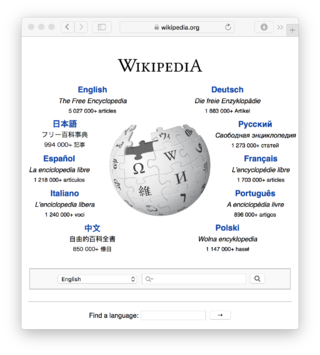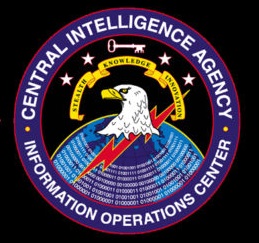Related Research Articles
Steganography is the practice of representing information within another message or physical object, in such a manner that the presence of the concealed information would not be evident to an unsuspecting person's examination. In computing/electronic contexts, a computer file, message, image, or video is concealed within another file, message, image, or video. The word steganography comes from Greek steganographia, which combines the words steganós, meaning "covered or concealed", and -graphia meaning "writing".

A wiki is a form of hypertext publication on the internet which is collaboratively edited and managed by its audience directly through a web browser. A typical wiki contains multiple pages that can either be edited by the public or limited to use within an organization for maintaining its internal knowledge base.

Wiki software is collaborative software that runs a wiki, which allows the users to create and collaboratively edit pages or entries via a web browser. A wiki system is usually a web application that runs on one or more web servers. The content, including previous revisions, is usually stored in either a file system or a database. Wikis are a type of web content management system, and the most commonly supported off-the-shelf software that web hosting facilities offer.

LyX is an open source, graphical user interface document processor based on the LaTeX typesetting system. Unlike most word processors, which follow the WYSIWYG paradigm, LyX has a WYSIWYM approach, where what shows up on the screen roughly depicts the semantic structure of the page and is only an approximation of the document produced by TeX.
A canary trap is a method for exposing an information leak by giving different versions of a sensitive document to each of several suspects and seeing which version gets leaked. It could be one false statement, to see whether sensitive information gets out to other people as well. Special attention is paid to the quality of the prose of the unique language, in the hopes that the suspect will repeat it verbatim in the leak, thereby identifying the version of the document.
A tracking system or defect tracking system is a software application that keeps track of reported software bugs in software development projects. It may be regarded as a type of issue tracking system.
A web content management system is a software content management system (CMS) specifically for web content. It provides website authoring, collaboration, and administration tools that help users with little knowledge of web programming languages or markup languages create and manage website content. A WCMS provides the foundation for collaboration, providing users the ability to manage documents and output for multiple author editing and participation. Most systems use a content repository or a database to store page content, metadata, and other information assets the system needs.
This article compares computer software tools that are used for accomplishing comparisons of files of various types. The file types addressed by individual file comparison apps varies but may include text, symbols, images, audio, or video. This category of software tool is often called "file comparison" or "diff tool", but those effectively are equivalent terms — where the term "diff" is more commonly associated with the Unix diff utility.
GBDE, standing for GEOM Based Disk Encryption, is a block device-layer disk encryption system written for FreeBSD, initially introduced in version 5.0. It is based on the GEOM disk framework. GBDE was designed and implemented by Poul-Henning Kamp and Network Associates Inc..
Video fingerprinting or video hashing are a class of dimension reduction techniques in which a system identifies, extracts and then summarizes characteristic components of a video as a unique or a set of multiple perceptual hashes or fingerprints, enabling that video to be uniquely identified. This technology has proven to be effective at searching and comparing video files.

Accounting software is a computer program that maintains account books on computers, including recording transactions and account balances. It may depend on virtual thinking. Depending on the purpose, the software can manage budgets, perform accounting tasks for multiple currencies, perform payroll and customer relationship management, and prepare financial reporting. Work to have accounting functions be implemented on computers goes back to the earliest days of electronic data processing. Over time, accounting software has revolutionized from supporting basic accounting operations to performing real-time accounting and supporting financial processing and reporting. Cloud accounting software was first introduced in 2011, and it allowed the performance of all accounting functions through the internet.

The history of wikis began in 1994, when Ward Cunningham gave the name "WikiWikiWeb" to the knowledge base, which ran on his company's website at c2.com, and the wiki software that powered it. The wiki went public in March 1995, the date used in anniversary celebrations of the wiki's origins. c2.com is thus the first true wiki, or a website with pages and links that can be easily edited via the browser, with a reliable version history for each page. He chose "WikiWikiWeb" as the name based on his memories of the "Wiki Wiki Shuttle" at Honolulu International Airport, and because "wiki" is the Hawaiian word for "quick".
A Digital Cinema Package (DCP) is a collection of digital files used to store and convey digital cinema (DC) audio, image, and data streams.
INDECT is a research project in the area of intelligent security systems performed by several European universities since 2009 and funded by the European Union. The purpose of the project is to involve European scientists and researchers in the development of solutions to and tools for automatic threat detection through e.g. processing of CCTV camera data streams, standardization of video sequence quality for user applications, threat detection in computer networks as well as data and privacy protection.

Cinavia, originally called Verance Copy Management System for Audiovisual Content (VCMS/AV), is an analog watermarking and steganography system under development by Verance since 1999, and released in 2010. In conjunction with the existing Advanced Access Content System (AACS) digital rights management (DRM) inclusion of Cinavia watermarking detection support became mandatory for all consumer Blu-ray Disc players from 2012.

Foswiki is an enterprise wiki, typically used to run a collaboration platform, knowledge base or document management system. Users can create wiki applications using the Topic Markup Language (TML), and developers can extend its functionality with plugins.

Whonix is a Linux distribution, based on Kicksecure OS, claimed to be security hardened by its developers.

Vault 7 is a series of documents that WikiLeaks began to publish on 7 March 2017, detailing the activities and capabilities of the United States Central Intelligence Agency (CIA) to perform electronic surveillance and cyber warfare. The files, dating from 2013 to 2016, include details on the agency's software capabilities, such as the ability to compromise cars, smart TVs, web browsers including Google Chrome, Microsoft Edge, Mozilla Firefox, and Opera, the operating systems of most smartphones including Apple's iOS and Google's Android, and computer operating systems including Microsoft Windows, macOS, and Linux. A CIA internal audit identified 91 malware tools out of more than 500 tools in use in 2016 being compromised by the release. The tools were developed by the Operations Support Branch of the CIA.
References
- ↑ Kumar, Gaurav. "Novel Method for Watermarking Java Program". International Journal of Emerging Technology and Advanced Engineering.
- ↑ Öksüz, Abdullah Çağlar; Ayday, Erman; Güdükbay, Uğur (2021-09-01). "Privacy-preserving and robust watermarking on sequential genome data using belief propagation and local differential privacy". Bioinformatics. 37 (17): 2668–2674. doi:10.1093/bioinformatics/btab128. hdl: 11693/53979 . ISSN 1367-4803. PMC 11025661 . PMID 33630065.